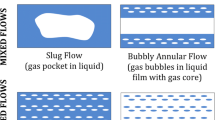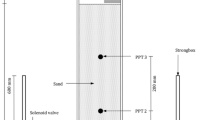Abstract
The two proposed conceptual models explaining partially saturated flow from soil into fractured rock in the intermediate fractured vadose zone have not been confirmed due to the difficulty involved in observing the soil–rock interface in situ. To address that challenge, this paper presents a series of newly developed physical experiments using a geotechnical centrifuge model of sand overlying a single dry clean smooth vertical fracture. The model shows the development of a perched water system and a saturated wetting front that progresses transversely along the interface, while breaching through the interface occurs via multiple point sources. The dominant flow mechanisms within the fracture comprise droplets, discontinuous rivulets with droplet formation, and continuous rivulets. A maximum drainage area of 30% of the width of the fracture contributes to the flow in the model, and this drainage area decreases with depth due to the merging of oscillating rivulets in the upper regions of the fracture. The presence of evidence supporting both conceptual models shows that a combined conceptual model is required to accurately explain partially saturated flow at the soil–rock interface.












Similar content being viewed by others
References
Appels WM, Graham CB, Freer JE, McDonnell JJ (2015) Factors affecting the spatial pattern of bedrock groundwater recharge at the hillslope scale. Hydrol Proc 29:4594–4610
Archer A (2014). Using small-strain stiffness to predict the settlement of shallow foundations on sand. M Eng (Geotechnical Engineering) dissertation. University of Pretoria, Pretoria
Banks EW, Simmons CT, Love AJ, Cranswick R, Werner AD, Bestland EA, Wood M, Wilson T (2009) Fractured bedrock and saprolite hydrogeologic controls on groundwater/surface-water interaction: a conceptual model (Australia). Hydrogeol J 17(8):1969–1989
Boisson A, Guihéneuf N, Perrin J, Bour O, Dewandel B, Dausse A, Viossanges M, Ahmed S, Maréchal JC (2015) Determining the vertical evolution of hydrodynamic parameters in weathered and fractured South Indian crystalline-rock aquifers: insights from a study on an instrumented site. Hydrogeol J 23(4):757–773
Butterfield R (2000) Scale-modelling of fluid flow in geotechnical centrifuges. Soils Found 40(6):39–45
Buttle JM, Mcdonald DJ (2002) Coupled vertical and lateral preferential flow on a forested slope. Water Resour Res 38(5):18–11
Culligan-Hensley PJ, Savvidou C (1995) Environmental geomechanics and transport processes. In: Taylor R (ed) Geotechnical centrifuge technology. Blackie Academic and Professional, Glasgow, pp 196–264
Culligan PJ, Barry DA (1998) Similitude requirements for modelling NAPL movement with a geotechnical centrifuge. Proc Inst Civ Eng Geotech Eng 180–186
Della Volpe C, Maniglio D, Morra M, Siboni S (2002) The determination of a ‘stable-equilibrium’ contact angle on heterogeneous and rough surfaces. Colloids Surf A 206(1):47–67
Dippenaar MA (2014a) Towards hydrological and geochemical understanding of an ephemeral palustrine perched water table “wetland” (Lanseria gneiss, Midrand, South Africa). Environ Earth Sci 72(7):2447–2456
Dippenaar MA (2014b) Porosity reviewed: quantitative multi-disciplinary understanding, recent advances and applications in vadose zone hydrology. Geotech Geol Eng 32:1–19
Dippenaar MA, Van Rooy JL (2016) On the cubic law and variably saturated flow through discrete open rough-walled discontinuities. Int J Rock Mech Min Sci 89:200–211
Doe TW (2001) What do drops do? Surface wetting and network geometry effects on vadose-zone fracture flow. In: National Research Council (ed) Conceptional models of flow and transport in the fractured vadose zone. The National Academies, Washington, DC, pp 243–270
Dragila MI, Weisbrod N (2003) Parameters affecting maximum fluid transport in large aperture fractures. Adv Water Resour 26(12):1219–1228
Dragila MI, Wheatcraft SW (2001) Free-surface films. In: National Research Council (ed) Conceptional models of flow and transport in the fractured vadose zone. The National Academies, Washington, DC, pp 217–241
Faybishenko B, Doughty C, Steiger M, Long JC, Wood TR, Jacobsen JS, Lore J, Zawislanski PT (2000) Conceptual model of the geometry and physics of water flow in a fractured basalt vadose zone. Water Resour Res 36(12):3499–3520
Fujimoto M, Kosugi KI, Tani M, Banba N, Fukagawa R (2014) Evaluation of bedrock groundwater movement in a weathered granite hillslope using tracer methods. Int J Erosion Control Eng 7(1):32–40
Garnier J, Gaudin C, Springman SM, Culligan PJ, Goodings DJ, Konig D, Kuttervii B, Phillips R, Randolph MF, Thorel L (2007) Catalogue of scaling laws and similitude questions in geotechnical centrifuge modelling. In J Phys Model Geotech 7(3):1–23
Ghezzehei TA (2004) Constraints for flow regimes on smooth fracture surfaces. Water Resour Res 40(11):W11503
Graham CB, Woods RA, McDonnell JJ (2010) Hillslope threshold response to rainfall: (1) A field based forensic approach. J Hydrol 393(1):65–76
Greco R, Comegna L, Damiano E, Guida A, Olivares L, Picarelli L (2014) Conceptual hydrological modeling of the soil-bedrock interface at the bottom of the pyroclastic cover of Cervinara (Italy). Procedia Earth and Planetary Science, 9, pp 122–131
Hsieh PA, Bahr JM, Doe TW, Flint AL, Gee G, Gelhar LW, Solomon DK, van Genuchten M, Wheatcrsaft SW (2001) Panel report. In: National Research Council (ed) Conceptional models of flow and transport in the fractured vadose zone. The National Academies, Washington, DC, pp 9–44
Huang X, Shi ZH, Zhu HD, Zhang HY, Ai L, Yin W (2016) Soil moisture dynamics within soil profiles and associated environmental controls. Catena 136:189–196
Jacobsz SW, Kearsley EP, Kock JHL (2014) The geotechnical centrifuge facility at the University of Pretoria. In ICPMG2014–Physical Modelling in Geotechnics: Proceedings of the 8th International Conference on Physical Modelling in Geotechnics 2014 (ICPMG2014), Perth, Australia, 14-17 January 2014 (p. 169), CRC Press
Jones BR, Brouwers LB, van Tonder WD, Dippenaar MA (2017a) Assessing geotechnical centrifuge modelling in addressing variably saturated flow in soil and fractured rock. Environ Sci Pollut Res 24(15):13203–13223. https://doi.org/10.1007/s11356-016-8333-2
Jones BR, Brouwers LB, Dippenaar MA (2017b) Partially to fully saturated flow through smooth, clean, open fractures: qualitative experimental studies. Hydrogeol J. https://doi.org/10.1007/s10040-017-1680-3
Kaytech (2014) BIDIM technical data sheet with new SANS standards (ref DS FLTR 0587–08/2014). Kaytech, Durban
Kordilla J, Tartakovsky AM, Geyer T (2013) A smoothed particle hydrodynamics model for droplet and film flow on smooth and rough fracture surfaces. Adv Water Resour 59:1–14
Kosugi KI, Katsura SY, Katsuyama M, Mizuyama T (2006) Water flow processes in weathered granitic bedrock and their effects on runoff generation in a small headwater catchment. Water Resour Res 42(2):W02414
Kumar PR (2007) Scaling laws and experimental modelling of contaminant transport mechanism through soils in a geotechnical centrifuge. Geotech Geol Eng 25(5):581–590
Lebeau M, Konrad JM (2010) A new capillary and thin film flow model for predicting the hydraulic conductivity of unsaturated porous media. Water Resour Res 46(12):W12554
Liang WL, Uchida T (2014) Effects of topography and soil depth on saturated-zone dynamics in steep hillslopes explored using the three-dimensional Richards’ equation. J Hydrol 510:124–136
Masaoka N, Yamakawa Y, Kosugi KI, Mizuyama T, Tsutsumi D (2010) Intensive measurements of soil pore water pressure for analyzing heterogeneous hydrological processes on a hillslope. Int J Erosion Control Eng 3(1):53–58
Nicholl M, Glass RJ Wheatcraft SW (1994) Gravity-driven infiltration instability in initially dry nonhorizontal fractures. Water Resour Res 30(9):2533–2546
Nimmo JR (2005) Unsaturated zone flow processes. In: Anderson MG, Bear J (eds) Encyclopedia of hydrological sciences: part 13—groundwater. Wiley, Chichester, pp 2299–2322
Nimmo JR (2010) Theory for source-responsive and free-surface film modeling of unsaturated flow. Vadose Zone J 9(2):295–306
Or D (2008) Scaling of capillary, gravity and viscous forces affecting flow morphology in unsaturated porous media. Adv Water Resour 31(9):1129–1136
Or D, Ghezzehei TA (2007) Traveling liquid bridges in unsaturated fractured porous media. Transp Porous Media 68(1):129–151
Or D, Tuller M (2000) Flow in unsaturated fractured porous media: hydraulic conductivity of rough surfaces. Water Resour Res 36(5):1165–1177
Peters A, Durner W (2008) A simple model for describing hydraulic conductivity in unsaturated porous media accounting for film and capillary flow. Water Resour Res 44(11):W11417
Phillips R (1995) Chapter 3: Centrifuge modelling: practical considerations. In: Taylor RE (ed) Geotechnical centrifuge technology. CRC, Boca Raton
Pruess K (1999) A mechanistic model for water seepage through thick unsaturated zones in fractured rocks of low matrix permeability. Water Resour Res 35(4):1039–1051
Salve R, Rempe DM, Dietrich WE (2012) Rain, rock moisture dynamics, and the rapid response of perched groundwater in weathered, fractured argillite underlying a steep hillslope. Water Resour Res 48(11):W11528
Singhal BBS, Gupta RP (2010) Applied hydrogeology of fractured rocks. Springer, Dordrecht
Sohrt J, Ries F, Sauter M, Lange J (2014) Significance of preferential flow at the rock soil interface in a semi-arid karst environment. Catena 123:1–10
Su GW, Geller JT, Pruess K, Wen F (1999) Experimental studies of water seepage and intermittent flow in unsaturated, rough-walled fractures. Water Resour Res 35(4):1019–1037
Taylor RN (1995) Chapter 2: Centrifuges in modeling: principles and scale effects. In: Taylor RE (ed) Geotechnical centrifuge technology. CRC, Boca Raton
Tokunaga TK, Wan J (1997) Water film flow along fracture surfaces of porous rock. Water Resour Res 33(6):1287–1295
Tokunaga TK, Wan J (2001) Approximate boundaries between different flow regimes in fractured rocks. Water Resour Res 37(8):2103–2111
Tokunaga TK, Olson KR, Wan J (2005) Infiltration flux distributions in unsaturated rock deposits and their potential implications for fractured rock formations. Geophys Res Lett 32(5):L05405
Tromp-van Meerveld HJ, McDonnell JJ (2006) Threshold relations in subsurface stormflow: 2. The fill and spill hypothesis. Water Resour Res 42(2). https://doi.org/10.1029/2004WR003800
Tuller M, Or D (2002) Unsaturated hydraulic conductivity of structured porous media. Vadose Zone J 1(1):14–37
Van Tonder WD, Jacobsz SW (2017) Seepage column hydraulic conductivity tests in the geotechnical centrifuge. J S Afr Inst Civil Eng 59(3):16–24
Wang JSY, Narasimhan TN (1993) Unsaturated flow in fractured porous media. In: Bear J, Tsang C-F, De Marsily G (eds) Flow and contaminant transport in fractured rock. Academic, San Diego, pp 325–391
Zhang ZF (2011) Soil water retention and relative permeability for conditions from oven-dry to full saturation. Vadose Zone J 10(4):1299–1308
Acknowledgements
The authors wish to acknowledge the South African Water Research Commission (www.wrc.org.za) for their continuous funding of ongoing research through projects K5/2326 (on the intermediate vadose zone) and K5/2449 (on contaminant transport through the vadose zone from cemetery sites).
Author information
Authors and Affiliations
Corresponding author
Ethics declarations
Declaration
The authors extend their appreciation to the journal, its editors and reviewers.
Conflict of interest
The authors declare no conflict of interest.
Rights and permissions
About this article
Cite this article
Brouwers, L.B., Dippenaar, M.A. Partially saturated flow from sand into a discrete smooth open vertical fracture at the soil–rock interface: experimental studies. Bull Eng Geol Environ 78, 2575–2590 (2019). https://doi.org/10.1007/s10064-018-1258-x
Received:
Accepted:
Published:
Issue Date:
DOI: https://doi.org/10.1007/s10064-018-1258-x




